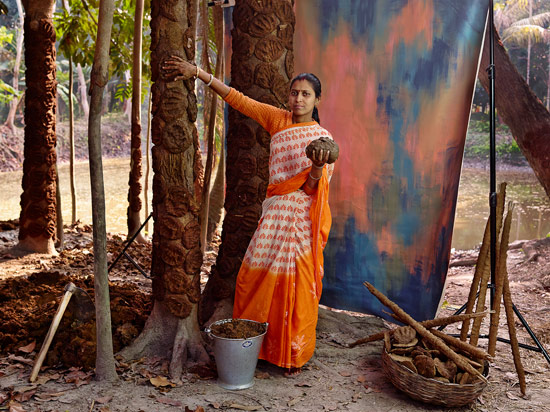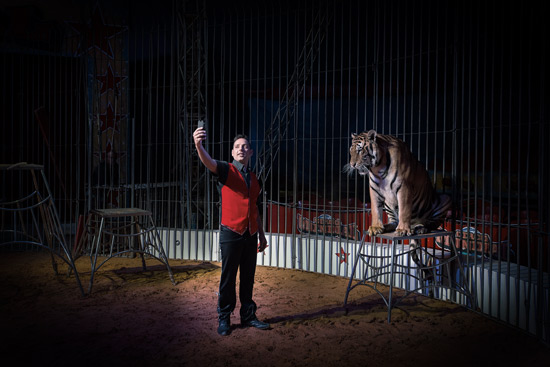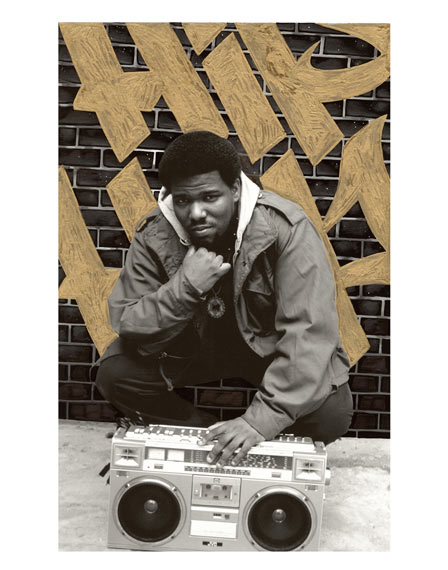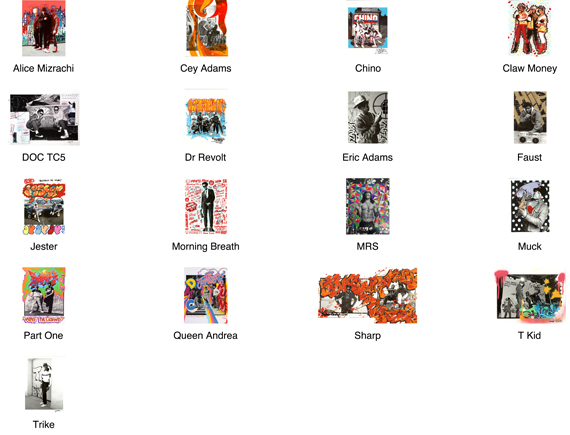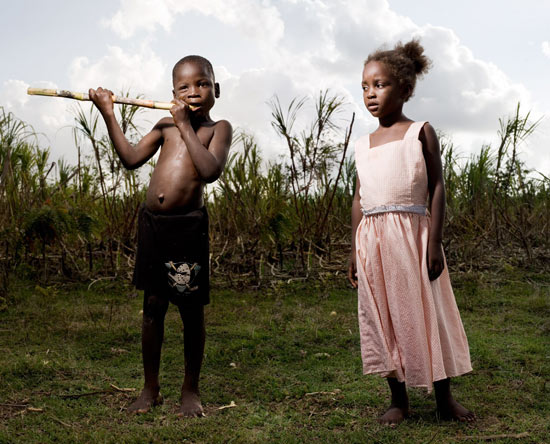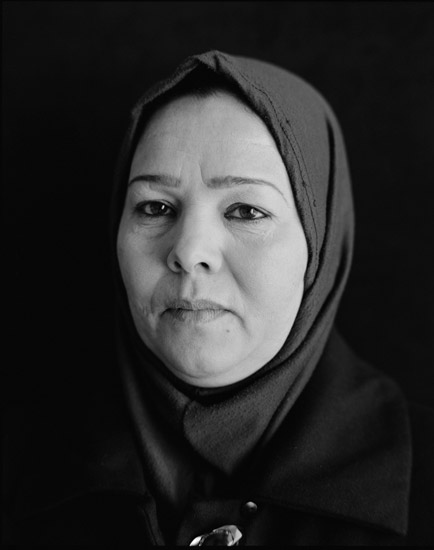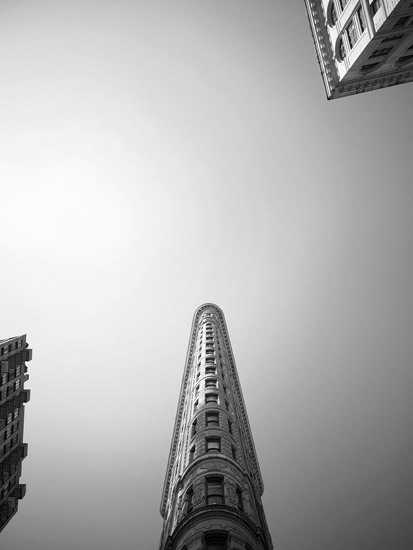Alice Mizrahi "I started spraying in 2005 but I already had a studio practice and was formally trained at Parsons. Merging the two was a natural progression. I had been immersed in graff and hip hop culture as a young girl through my brother. The first official mural I painted was in 2005 for The Meeting of Styles in Greenpoint, Brooklyn. Before that, I remember catching tags in my neighborhood as a teenager along a trail by the tracks we called the 'Go Path.'"
"I chose the Beastie Boys photo because I grew up listening to them and they were a huge influence in my work as a young artist coming up. I also love the red color in the photo and the live vibe I got when I saw it."
Cey Adams was the founding creative director of Def Jam Recordings and is known for his work with Beastie Boys, Public Enemy, LL Cool J, Run DMC, Jay-Z, and Mary J. Blige. "I was 16 or 17 when I first started writing graffiti. The first place I really wrote was my room. My parents used to get so angry."
"I was lucky enough to work with a lot of Janette's subjects. Keith was a really special guy and he always made you feel special when you were around him. I used to love going to his studio, this photo takes me right back to that time."
David "Chino" Villarente "The first tags I ever took were on the bathroom walls in my elementary school towards the tail end of the 6th grade, but I didn't start writing on trains until 1983, I was 15 years old."
"I chose Janette's photo of Stetsasonic posing in front of Stetson's Hats. I grew up downtown Brooklyn, not far from the Fulton Mall. In the mid/late 80's I was involved in a cross-out war with another graffiti writer. Several of my crossed out tags appear in the background of the photo I selected. The Stetsasonic photo was published in either Word Up or Right On magazine, this was the first time I saw my name in print."
Claw Money "I started writing in my early 20's - I was late to the party! The first wall I ever painted was in Jonone's studio in Paris in 1990. I think?!?!?"
"I chose Salt-n-Pepa. This was all about female empowerment and I loved these girls for it!"
DOC TC5 "I picked up my first spray can in 1977, I was 13 years old. I painted the bleachers in the handball court in Cypress Hill's Projects."
"I chose this photo because I couldn't let anyone else paint on Dondi White's face because I was one of his last students."
Dr. Revolt began his practice in 1977 as an original member of the historic New York City graffiti crew, The Rolling Thunder Writers (RTW). He contributed to classic hip-hop films "Wild Style" & "Style Wars" and created the 'YO! MTV RAPS' logo.
"I started writing too long ago - the 70s. First place I wrote? Wherever it was it was "funky." I didn't choose the Ultramagnetic photo, it was given to me. All the other good ones were taken. Actually I was inspired by the magnetic properties thereon."
Eric Adams "I started writing when I was a kid. As far back as I can remember trying to recreate everything I saw my Dad (Cey Adams) do. It just came to me naturally as time went on. I can't say I did a wall but the first thing I remember doing was a piece for my school back in 1996 for a play we were doing based on hip hop."
"The reason I chose the Flava Flav photo to do my piece on was because of my father and his connection with Def Jam and Public Enemy. I can remember plenty of photo shoots where I met the group and I even had the chance to take a photo with Flav when I was a kid. (One of my dad's favorite pictures) So I figured it would be awesome to do something on Janette's photo of him."
Faust "I was drawn to this photo of Afrika Bambaataa because I loved his pose and boombox, emblematic of the era, but also the brick wall was apropos for the collaboration. The ideal surface for a graffiti artist. I wrote the words "hip hop" in the background since he's often regarded as the Godfather of Hip Hop. The first time the term "hip hop" appeared in print was in a Village Voice interview with Bambaataa and he was also instrumental in the spread of hip hop culture worldwide."
Jester (credited as the originator of the 'Bubble' lettering) "I started writing at the age of 13 in 1971. I continued till I was 19, I only stopped because my daughter was born in '78 and I needed to put down the spray cans and pick up the diapers. First wall or first train? I'll go with first train, back in '71 I went to the 4 line layups one Saturday afternoon and jumped down on the tracks and did some tags on the side of the train. It was either 170 St or 176 St. What a rush!!"
"I chose EPMD photo, simply because they were one of my favorites from back in the day. I love their raps and have at least 3 of their tapes (yup tapes, remind me to transfer them ASAP)."
Morning Breath "We chose the image of Slick Rick because of its iconic impact, and felt it would work best with our style of graphics. It gave us the negative space to collaborate and bring something to the image without overpowering or making the figure insignificant in any way. We usually have done this style using a central illustrated image. it was nice to switch it up with a photographic element for this collaboration."
MRS "I started writing graffiti in high school, I think I was 16. I think the first place I wrote on illegally was a broken down fence in my neighborhood. I used fluorescent pink and black Rusto paint. It was very sloppy, very transparent, very poorly constructed all around but still as great as any of my most perfect pieces because it marked a new chapter of my life."
"I chose the image of Melle Mel because I was attracted to its energy. The brick wall behind him felt like a familiar canvas and a good place to start. My brother introduced me to his music when I was younger and I've been a fan ever since, this is also why I really wanted to work with this photo."
Muck "Long before this project, I started writing in Greece mid 80's behind a potato storage shed on the island of Lesbos, 93/94, I tagged the word "unity" and a globe blowing up."
"I chose the LL Cool J image cause I painted a green version of it once from a photo I found on the internet."
Part One "I began writing when I was 11 years old in the 7th grade. My first wall I painted was a school yard in my neighborhood of Spanish Harlem, I was 12 years old."
"I chose this image because I've always admired Eric B & Rakim for their contributions to the culture, especially Rakim for his acknowledgment."
Queen Andrea "I always loved to draw as a kid, but really began to consistently practice graffiti lettering when I was about 14, it was the first art form that truly fascinated me and I immersed myself in practicing tagging and letters. I was hellbent on learning how to do burners! My first real piece was on the outside of Lucky Strike restaurant on Grand Street in Soho, Manhattan, where I grew up. I was 15 years old."
"I started listening to RunDMC in 1984 when I was a little kid, with my older brother. They always had some of the most original, witty and hard hitting lyrics. They're still one of my all-time favorite hip hop groups."
Sharp "My connection to Janette as a photographer is deeply rooted, many of the images she captured in the golden age are moments that represent the formative years of my evolution of life into manhood. These photos are like forgotten postcards to my youth."
"I chose the picture of Donald Dee and Bronx Style Bob as it is a reflection of a period of time which holds a special place in my heart, in 1989 Los Angeles was 'the place'. This photo was more than likely taken in the parking lot at the video shoot for Donald Dee's debut album F.B.I.; I may have been standing a few feet away, I passed by that day to chill during the filming of the video."
T KID "I started writing graffiti at 12 yrs old when I was drafted into the neighborhood gang. My first tag was king13 at 16 yrs of age (1977). After getting shot due to gang violence I changed my name to Tkid170 and became a king of subway graffiti. I tagged the park I played in, it was on Morrison Ave and Watson Ave, south Bronx. Then it was nothing but subway cars."
"I chose the picture of Fab 5 Freddie from 1982 cause it was part of the wild style movie and since I'm an original member of the wild style gang I thought it would be appropriate."
Trike "I was just 10 years old when I started writing in the early 1970's. My first wall was in Red Hook, Brooklyn, all the way down at the pier."
"This photo of Dr Dre reminded me of the time when I was catching crazy throw ups in LA in 1981. So it was perfect. I thought if I was in South Central what would I have done? Obviously a quick throw up and get the hell out!"
